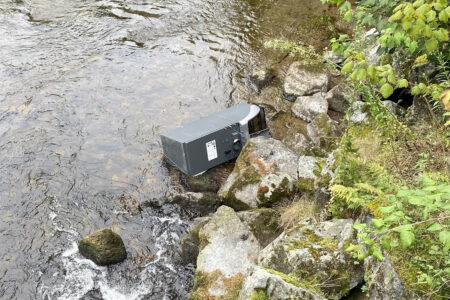Experts: Smoke hazards are difficult to predict
SARANAC LAKE — Smoke from Canadian wildfires made a return to the Tri-Lakes region for much of last week. Experts say that while the area should not expect any smoke the rest of this week, predicting when the next spell of poor air quality will occur remains difficult.
A key to understanding the impact that wildfire smoke can have on an area is how close to the surface the smoke is, according to Meteorologist Pete Banacos of the National Weather Service’s Burlington, Vermont office, which serves the Tri-Lakes region. If smoke from wildfires is confined to higher altitudes in the atmosphere, skies appear hazy, but the air that people breathe near the surface is not tainted. When smoke is unable to lift, and remains closer to the surface, air quality issues arise.
Meteorologists can assess snowpack and soil moisture in the spring to make general outlooks about wildfire prevalence for an upcoming season, according to Banacos. However, predicting specific periods of poor air quality from surface-level smoke for locations is much harder.
“It’s a difficult thing to forecast because you are dealing with the suppression of the fire (from either rain or firefighters), the growth of the fire, how vertically mixed the smoke is going to be in the atmosphere,” said Banacos. These uncertainties compound the further ahead computer models try to estimate smoke plume movements, rendering most forecasts beyond 48 hours unreliable.
Small differences in wind speed and direction can make a large impact on how rapidly smoke moves away from the surface and mixes in the atmosphere, or lingers where people breathe. To add to the uncertainty in forecasting, a wildfire’s growth can yield vastly different amounts of smoke depending on the composition of the area burning, according to Marshall Burke, a Stanford professor who studies wildfire smoke. There is immense variability in the smoke potential from mile to mile of wildfire, which is determined by the density, species, and water content of the brush. Ironically, areas that have received more water recently tend to produce more smoke once a fire begins burning.
While the smoke and haze have not been as prevalent in the area this season as they were in 2023, last week served as a reminder of the air quality issues the Tri-Lakes region suffered for much of last summer. Although Canada is experiencing another above-average wildfire season this year, most of the East Coast has been spared from the smoke.
Fires capable of producing enough smoke to cloud an entire region are extremely rare in the eastern U.S., given the abundant rainfall the region receives throughout the summer months. The smoke New York typically experiences, including last week and much of last summer, originates from Canada or the western U.S. There, thick forests that see little rain throughout the summer provide ample fuel for fires to rage. The smoke arrives in the Tri-Lakes region when atmospheric wind patterns put the area downwind of the fires.
While a favorable wind pattern is necessary for the possibility of smoke, it alone does not guarantee that the smoke will arrive, or, if it does, what type of impact on air quality it will have. A myriad of other variables determine the air quality conditions, according to Banacos. One of the most important is the proximity of the burns to the Tri-Lakes region, he said.
–
Location, location, location
–
Last year, more fires were burning across northern portions of Quebec and Nova Scotia, according to Banacos. This put New York at a much closer proximity to the smoke source than is typical with western Canadian fires.
“There was a dry lightning event that occurred across northern Quebec province in May (2023) that created a number of wildfires that burned throughout much of last summer,” he said. “Those fires were in relatively close proximity to northern New York whereas we typically see the smoke coming from the Canadian Rockies and western U.S.,” said Banacos.
The added distance to the west is crucial. As the smoke is carried two to three thousand miles to the east, it is dispersed higher into the atmosphere, according to Banacos.
“We’ll see a hazy sky, but it’s not necessarily interfering with air quality close to the ground,” he said. With last year’s smoke source only approximately 500 miles to the north, much more of the smoke was still trapped near the ground when the winds carried it into the Tri-Lakes.
“This impacted the air quality much more severely,” said Banacos.
This year, Canada’s eastern provinces have seen fewer wildfires. The fires have instead been primarily occurring across the more typically-prone western provinces of British Columbia, Alberta and Saskatchewan, according to Scott McKim, the science manager at the Atmospheric Sciences Research Center’s Whiteface Mountain Field Station.
In addition to rising higher in the atmosphere and away from where people breathe, the longer it takes smoke to arrive over a given area, the more potential there is for it to be cleansed from the atmosphere by rain, according to McKim.
“Rain processes often act to cleanse the atmosphere, effectively raining out many of the black carbon particles,” he wrote. McKim noted that this situation does not pose an acid rain threat to people or the environment, as the particles exist at too low of a concentration.
“There is not a threat (for) acid rain given particle concentrations in the atmosphere,” he said.
While Canada has not experienced as severe of a wildfire season as last year, 2024 is still above average. According to Natural Resources Canada, the government agency responsible for monitoring wildfires, 15,533 square miles have burned this season as of Aug. 14, the most recent date the agency has reported at press time. The 10-year seasonal average up to Aug. 14 is 8,913 square miles, making this season close to double what is normal so far. One single fire currently burning in Alberta is over 1,800 square miles, according to McKim.
Most wildfires across Canada occur in such remote areas that they are nearly impossible to control. They are typically ignited by lightning strikes over dry forests. While wildfires are naturally occurring, decreasing snowpacks in recent years have allowed the Canadian forests to dry up earlier in the spring, resulting in more combustible brush when early summer thunderstorms begin. This has resulted in larger and more numerous wildfires in recent summers.
People can stay up-to-date on wildfire smoke levels by going to www.airnow.gov and entering their zip code. The website provides both current conditions and a short-range air quality index forecast for their area.




